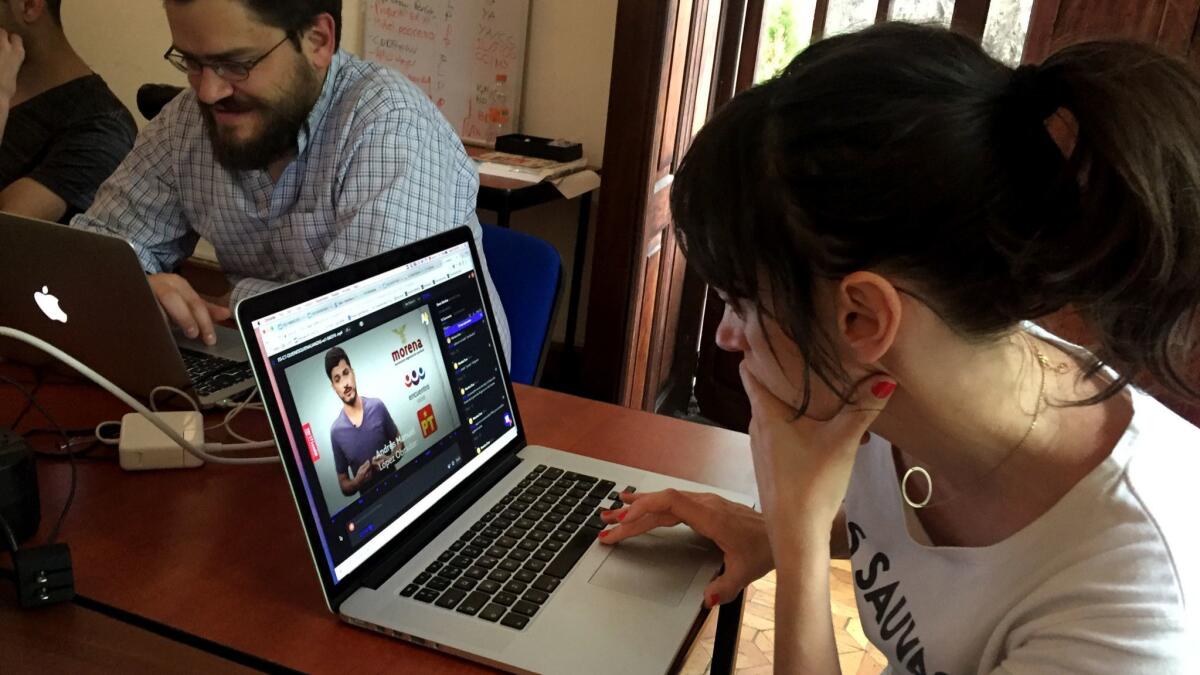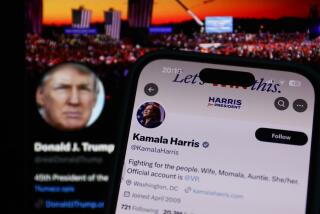Mexico has its own fake news crisis. These journalists are fighting back

Reporting from Mexico City ‚ÄĒ No, a candidate in Mexico‚Äôs upcoming presidential election did not pose nude with a drag queen.
No, the wife of another candidate is not the granddaughter of a Nazi.
And no, a third contender did not vow to win the election by buying votes.
These and other rumors have been debunked by a team of young journalists fighting against falsehoods that have circulated widely in the run-up to Mexico’s July 1 vote.
Hunched over laptops in their headquarters in an old house in Mexico City, about two dozen fact-checkers work around the clock knocking down fake news and verifying campaign claims that are correct. Their platform, Verificado 18, or Verified 18, works like a news service, with their fact-checks disseminated throughout the country via a large network of newspapers and online sites.
Fake news is everywhere in Mexico, pushed on Facebook, YouTube and Twitter by sham news sites and armies of digital bots. It’s been a problem here since before the issue gained global attention in the 2016 U.S. presidential election, with online disinformation campaigns playing a key role in Mexican politics since the country’s 2012 presidential race.
‚ÄúThere‚Äôs an information war,‚ÄĚ said Alba Mora Roca, a video journalist who is helping lead the effort. ‚ÄúWe‚Äôre defenders of the truth.‚ÄĚ
The platform was forged by two news websites ‚ÄĒ Mexico‚Äôs Animal Politico and AJ+ ‚ÄĒ and an organization called PopUp Newsroom, which led similar efforts to fact-check, verify and debunk claims made during the last U.S. election and in France‚Äôs 2017 presidential campaign. About 70 other media outlets, including some of Mexico‚Äôs most-read newspapers, have signed on to distribute the content.
Although it launched only last month, the platform is already having an impact, said Carlos Bravo Regidor, a political analyst and a professor at CIDE, a public research center in Mexico City.
Misinformation designed to smear candidates spreads like a virus, Bravo said. Verificado 18, he said, is ‚Äúcreating the antibodies to combat fake news.‚ÄĚ
The group has debunked dozens of wildly circulated internet myths and fake videos. In one clip manipulated with superimposed images and fake Spanish subtitles, a pair of Russian news anchors appear to announce that Russian President Vladimir Putin is endorsing Mexico’s populist front-runner Andres Manuel Lopez Obrador. Verificado 18 confirmed that the subtitles were made up, and the original newscast had nothing to do with Mexico.
The group also recently proved that an alleged communique from the Venezuelan government about its plans to intervene in Mexico’s election was actually fake. Former Mexican President Felipe Calderon, the husband of current presidential candidate Margarita Zavala, had tweeted a widely shared copy of the fraudulent letter.
While each of the five candidates on the presidential ballot has been targeted by made-up smears, Lopez Obrador is the most frequent victim, according to Verificado 18. Roughly 80% of fake stories, memes and videos identified by the group have targeted Lopez Obrador, who is running for president for a third time and is currently 10 points ahead of his nearest competition, center-right candidate Ricardo Anaya. Much of the content targeting Lopez Obrador originates from several Facebook pages that are designed to look like news websites and have hundreds of thousands of followers.
Globally, there is more awareness than ever about the dangers of misinformation spread on social media after reports that Russia used fake news to try to influence the U.S. election, and British firm Cambridge Analytica mined Facebook data to target voters. During the 2016 race, millions of American voters were exposed to fake news stories spread on Facebook and Twitter, including one that said Pope Francis had endorsed then-candidate Donald Trump, and another that claimed that an FBI agent investigating Hillary Clinton had been found dead in his apartment.
Despite growing concern, many users don‚Äôt have the media literacy to determine what is real news and what is not, Mora said. At the offices of Verificado 18 on a recent afternoon, she pulled up on her computer screen a highly circulated ‚Äúpoll‚ÄĚ supposedly from the New York Times that showed Mexico‚Äôs third-place candidate, Jose Antonio Meade, in first place.
‚ÄúWe journalists know that this doesn‚Äôt look like a real New York Times poll,‚ÄĚ she said, pointing out aspects of the graphic that appeared unprofessional. ‚ÄúBut not everyone knows that.‚ÄĚ
Manipulation of news coverage in Mexico predates the invention of social media and smartphones.
President Enrique Pe√Īa Nieto‚Äôs Institutional Revolutionary Party, or the PRI, held its uninterrupted grip on power from 1929 to 2000 thanks in part to its alliance with Mexico‚Äôs leading television broadcaster, Televisa, historians say. The station‚Äôs former owner of once referred to himself as ‚Äúa soldier for the PRI.‚ÄĚ
For decades, Televisa famously neglected opposition candidates in Mexican elections while devoting glowing coverage to the PRI’s nominees. When it did cover challengers, it sometimes falsely tied them controversial figures, such as when the network aired a photo of 1988 opposition candidate Cuauhtemoc Cardenas next to pictures of Fidel Castro and Soviet leader Nikita Khrushchev.
Allegations that Televisa unfairly favored Pe√Īa Nieto in the 2012 election spurred one of Mexico‚Äôs largest social protests in recent years, a movement known as Yo Soy 132. Meaning ‚ÄúI am 132,‚ÄĚ the name is an expression of solidarity with the 131 students who started the movement.
But increasingly, experts say, elections are playing out online. With an estimated 67 million social media users, Mexico has the seventh-most internet-connected electorate in the world.
The PRI and other parties have adapted accordingly, unleashing swarms of bots that created and pushed fake news during the 2012 election. A report published by Oxford University found that ‚Äúgovernment‚Äźsponsored spam‚Äźbots‚ÄĚ have stayed active during Pe√Īa Nieto‚Äôs presidency, and have been ‚Äúused to target journalists and spread disinformation on social media.‚ÄĚ
The bots are typically used to divert attention away from scandals or toward a certain candidate. After the disappearance of 43 students at a rural teacher‚Äôs college in 2014, activists launched a viral Twitter hashtag ‚ÄĒ #YaMeCanse, or ‚ÄúI am tired‚ÄĚ ‚ÄĒ that became a locus for organizing protests. Suddenly the hashtag was flooded with thousands of tweets that included random content that had nothing to do with the protests, rendering the hashtag unusable, according to journalists who documented the attack.
Verificado 18 says it’s likely that each of this year’s presidential candidates has digital strategies that include bots, and that it will document election-related bot strikes.
While Verificado 18‚Äôs work has opened it up to online attacks from supporters of different candidates who perhaps wanted some fake news to be true, Mora said the effort is paying off. In an era of increasing division, she feels like she‚Äôs working to bring people a little closer to the truth ‚ÄĒ and a little closer together.
‚ÄúNews feeds are more and more sophisticated, so we‚Äôre in these echo chambers, only seeing ads targeted to our profile,‚ÄĚ she said. ‚ÄúWe‚Äôre losing our common conversation,‚ÄĚ she said.
Which reminds us. No, Meade never said Mexicans must get used to gasoline and electricity price hikes. No, Lopez Obrador‚Äôs son does not own a black Lamborghini. And no, Forbes did not name Pe√Īa Nieto‚Äôs wife as one of the richest women in the world.
To read this article in Spanish, click here
Twitter: @katelinthicum
More to Read
Sign up for Essential California
The most important California stories and recommendations in your inbox every morning.
You may occasionally receive promotional content from the Los Angeles Times.











